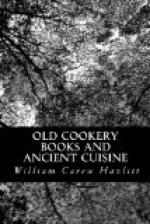Rear-suppers were not only held in private establishments, but in taverns; and in the early interlude of the “Four Elements,” given in my edition of Dodsley, and originally published about 1519, a very graphic and edifying scene occurs of a party of roisterers ordering and enjoying an entertainment of this kind. About seventy years later, Robert Greene, the playwright, fell a victim to a surfeit of pickled herrings and Rhenish wine, at some merry gathering of his intimates falling under this denomination. Who will venture to deny that the first person who kept unreasonable hours was an author and a poet? Even Shakespeare is not exempt from the suspicion of having hastened his end by indulgence with one or two friends in a gay carouse of this kind.
The author of the “Description of England” enlightens us somewhat on the sort of kitchen which the middle class and yeomanry of his time deemed fit and sufficient. The merchant or private gentleman had usually from one to three dishes on the table when there were no visitors, and from four to six when there was company. What the yeoman’s every-day diet was Harrison does not express; but at Christmas he had brawn, pudding and souse, with mustard; beef, mutton, and pork; shred pies, goose, pig, capon, turkey, veal, cheese, apples, etc., with good drink, and a blazing fire in the hall. The farmer’s bill of fare varied according to the season: in Lent, red herrings and salt fish; at Easter, veal and bacon; at Martinmas, salted beef; at Midsummer, fresh beef, peas, and salad; at Michaelmas, fresh herrings and fat mutton; at All Saints’, pork and peas and fish; and at Christmas, the same dainties as our yeoman, with good cheer and pastime.
The modern luncheon or nuncheon was the archaic prandium, or under-meat, displaced by the breakfast, and modified in its character by the different distribution of the daily repasts, so that, instead of being the earliest regular meal, like the grand dejeuner of the French, or coming, like our luncheon, between breakfast and dinner, it interposed itself between the noontide dinner and the evening supper. Now, with an increasing proportion of the community, the universal luncheon, postponed to a later hour, is the actual dinner; and our under-meal is the afternoon tea.
In those not-wholly-to-be-discommended days, the residue of the meal was consumed in the servants’ hall, and the scraps bestowed on the poor at the gate; and the last part of the business was carried out, not as a matter of chance or caprice, but on as methodical a principle as the payment of a poor-rate. At the servants’ table, besides the waiters and other attendants on the principal board, mentioned by Harrison, sat the master-cook, the pantler, the steward or major-domo, the butler, the cellarman, the waferer, and others. It was not till comparatively recent times that the wafery, a special department of the royal kitchen, where the confectionery and pastry were prepared, was discontinued.




